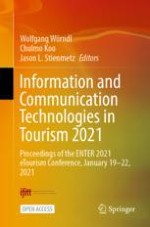1 Introduction
2 Literature Review
2.1 Destination Image
2.2 Destination Imagery
2.3 Research Questions
3 Method
3.1 First Phase
3.2 Second Phase
4 Results and Discussions
4.1 Respondent Profile
Description | France | Italy | ||
|---|---|---|---|---|
Age | Number | Percentage | Number | Percentage |
18–29 | 133 | 67 | 140 | 69 |
30–39 | 38 | 19 | 42 | 21 |
40–49 | 17 | 9 | 11 | 6 |
50–59 | 9 | 5 | 5 | 3 |
60 and above | 3 | 2 | 1 | 1 |
Total | 200 | 100 | 199 | 100 |
Gender | ||||
Male | 101 | 51 | 124 | 62 |
Female | 99 | 49 | 75 | 38 |
Total | 200 | 100 | 199 | 100 |
Travel experience | ||||
Never visited | 108 | 54 | 125 | 63 |
Visited | 92 | 46 | 71 | 27 |
Total | 200 | 100 | 199 | 100 |
4.2 Association Strength and Association Valence
France | Italy | |||||
|---|---|---|---|---|---|---|
Statements | AS | AV | Q | AS | AV | Q |
1. A country between mountains and lakes | 4.47 | 2.49 | 1 | 4.09 | 2.20 | 1 |
2. Safe | 3.76 | 2.30 | 1 | 3.87 | 2.46 | 1 |
3. Multiculturalism, multi-lingual | 3.65 | 1.95 | 1 | 3.13 | 1.76 | 2 |
4. Offers many outdoor activities with amazing views | 3.84 | 2.08 | 1 | 3.59 | 2.05 | 1 |
5. Enjoy nature, connect with nature | 3.79 | 2.34 | 1 | 3.44 | 1.94 | 1 |
6. Fondue, raclette, cheese, and chocolate | 4.13 | 2.00 | 1 | 3.75 | 1.88 | 1 |
7. Beautiful landscape, scenic views | 4.34 | 2.77 | 1 | 3.91 | 2.57 | 1 |
8. Precision and organized | 3.44 | 1.22 | 3 | 4.13 | 2.09 | 1 |
9. Easy and efficient transportations throughout the journey | 3.28 | 2.08 | 2 | 3.64 | 2.42 | 1 |
10. Transportation is a travel experience itself | 2.88 | 1.45 | 3 | 3.02 | 1.75 | 2 |
11. Festivals and Carnival | 2.83 | 1.30 | 3 | 2.15 | 1.00 | 3 |
12. St. Moritz, Zermatt, and Matterhorn | 2.72 | 0.81 | 3 | 3.05 | 0.93 | 3 |
13. Calm, peaceful, tranquil | 4.01 | 2.14 | 1 | 3.82 | 2.02 | 1 |
14. Authentic untouched nature | 3.83 | 2.53 | 1 | 3.60 | 2.38 | 1 |
15. Fresh air, clear water, and clean environment | 4.15 | 2.61 | 1 | 3.75 | 2.55 | 1 |
16. Expensive | 4.06 | −1.84 | 4 | 3.56 | −1.35 | 4 |
17. Money or bank | 3.66 | −0.40 | 4 | 3.86 | −0.03 | 4 |
18. Boring | 1.72 | −1.90 | 3 | 1.64 | −1.97 | 3 |
19. Rule based country, strict | 3.28 | −0.01 | 3 | 3.40 | 0.77 | 3 |
20. Switzerland is picturesque | 3.71 | 2.01 | 1 | 3.06 | 1.67 | 2 |
21. Healthy life style | 3.20 | 1.65 | 2 | 3.21 | 1.80 | 2 |
22. Welcoming or friendly | 3.14 | 2.16 | 2 | 2.83 | 2.06 | 2 |
23. Quiet and discreet | 3.70 | 1.71 | 1 | 3.68 | 1.92 | 1 |
Average | 3.55 | 1.45 | 3.4 | 1.55 | ||
4.3 Destination Imagery Diagnosis Model
-
First Quadrant: Strong association strength, and positive valence. Hence, it is named Treasures.
-
Second Quadrant: Weak association strength, but positive valence. Its name is Hidden Gems.
-
Third Quadrant: Weak association strength, and negative valence. Consequently, the name is Traps.
-
Fourth Quadrant: Strong association strength, but negative valence. It is named as Roadblocks.
